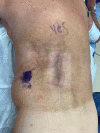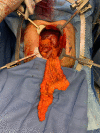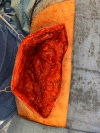Omental Flap to Non-healing Posterior Trunk Wound: A Case Report
- PMID: 35004003
- PMCID: PMC8723772
- DOI: 10.7759/cureus.20178
Omental Flap to Non-healing Posterior Trunk Wound: A Case Report
Abstract
Large posterior trunk wounds often require flap reconstruction. One option for posterior truncal reconstruction not readily considered, often due to the combined anterior and posterior approaches required for harvesting and coverage, is the omental flap; however, the omental flap stands as a robust backup in non-healing wounds when local flap options have been exhausted. We present a case of a posterior trunk wound that had previously undergone multiple unsuccessful local and regional flaps for reconstruction and was ultimately treated with a pedicled omental flap which went on to heal without any post-operative complications.
Keywords: back reconstruction; chronic back wound reconstruction; omental flap; posterior chest wall reconstruction; posterior trunk reconstruction.
Copyright © 2021, Laun et al.
Conflict of interest statement
The authors have declared that no competing interests exist.
Figures





References
-
- Management of posterior trunk defects. Mathes DW, Thornton JF, Rohrich RJ. Plast Reconstr Surg. 2006;118:73–83. - PubMed
-
- Pedicled greater omentum transferred to the spine in a case of postoperative infection. Giordano PA, Griffet J, Argenson C. Plast Reconstr Surg. 1994;93:1508–1511. - PubMed
-
- The laparoscopically harvested omental flap for deep sternal wound infection. van Wingerden JJ, Coret ME, van Nieuwenhoven CA, Totté ER. Eur J Cardiothorac Surg. 2010;37:87–92. - PubMed
-
- Use of a pedicled omental flap in the treatment of chest wall tuberculosis. Zhang N, Xu QZ, Fu XN, Sun W. Ann Thorac Surg. 2012;93:1010–1012. - PubMed
Publication types
LinkOut - more resources
Full Text Sources
